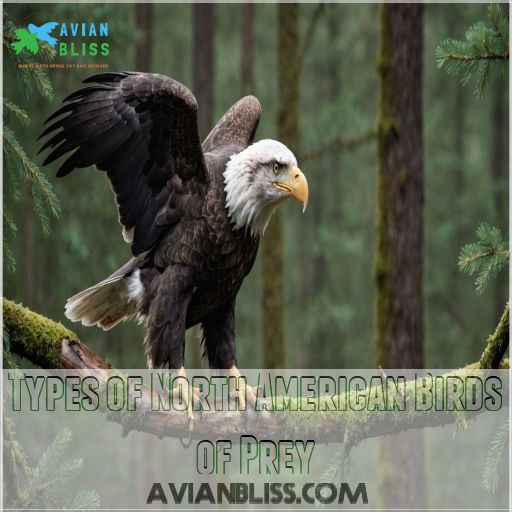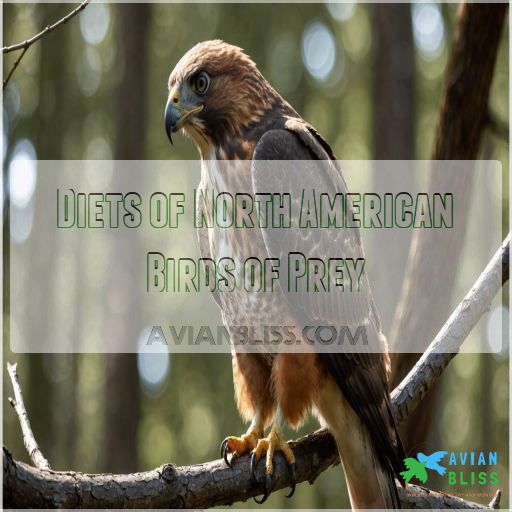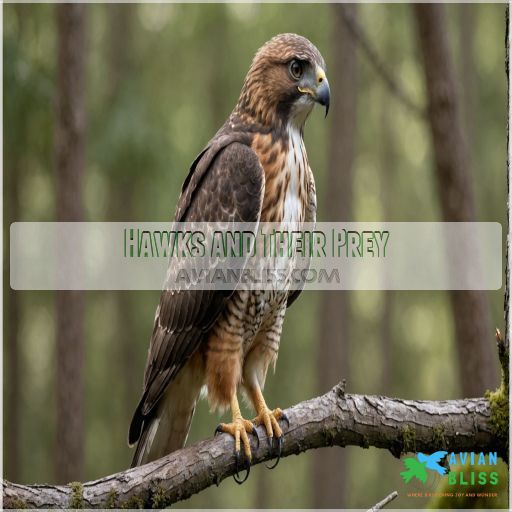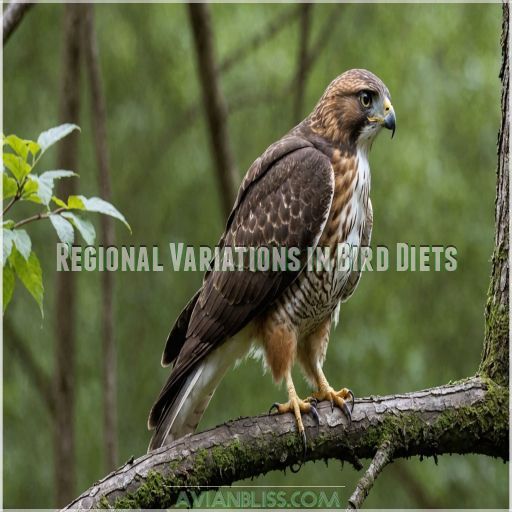This site is supported by our readers. We may earn a commission, at no cost to you, if you purchase through links.

Hawks prefer eyeing mammals like rabbits from highways, while falcons dive-bomb at blinding speeds to catch birds mid-air. Eagles, those majestic hunters, switch between fish and mammals based on what’s available.
Then there’s the quiet assassin—owls—who swoop silently in the dark for mice. And don’t forget vultures, nature’s cleanup crew, feasting on carrion.
These adaptable hunters have mastered their environment, ensuring survival despite human impact. But what challenges lie ahead for these majestic predators? Stay tuned to explore more.
Table Of Contents
- Key Takeaways
- Types of North American Birds of Prey
- Diets of North American Birds of Prey
- Hawks and Their Prey
- Falcons and Aerial Hunting
- Eagles and Their Prey
- Owls and Nocturnal Hunting
- Vultures and Scavenging
- Regional Variations in Bird Diets
- Human Impact on Bird of Prey Diets
- Conservation and Research
- Frequently Asked Questions (FAQs)
- What do birds of prey eat?
- What are the different types of birds of prey?
- What is a bird of prey?
- What are the largest birds of prey in North America?
- Which hawk species is the most prevalent in the Americas?
- What do the birds of prey eat?
- What is the most common bird of prey in North America?
- What is the best food for birds of prey?
- What do eagles and hawks eat?
- How do birds of prey spot their food?
- What adaptations help birds of prey hunt?
- Are human activities affecting raptor food availability?
- Which prey animals are most vulnerable to raptors?
- Do prey animals recognize bird of prey silhouettes?
- Conclusion
Key Takeaways
- You might think falcons are speedy show-offs, but they’re epic aerial acrobats, diving at over 200 mph to catch birds mid-air. Imagine being a master of the skies—it’s like having your personal air show every day!
- Owls, the stealthy night stalkers, use their incredible night vision and satellite-dish hearing to hunt in pitch black, swooping silently like nocturnal ninjas. Think of them as Nature’s own Batman with wings!
- Eagles, those majestic buffet-goers, feast on fish and mammals, adjusting their menu to what’s available. They’re like your friend who’s always game for whatever’s cooking, from sushi to steak!
- Vultures are the ecosystem’s uncompromising janitors, scarfing down carrion and keeping things tidy. They’re the birds you want at the party cleanup, ensuring nothing goes to waste.
Types of North American Birds of Prey
You’re in for a treat as you explore the diverse world of North American birds of prey, from the soaring eagles to the stealthy owls.
Each bird has its own unique features and hunting styles that make them fascinating hunters in the wild.
Hawks, Eagles, Falcons, Owls, and Vultures
Let’s explore the fascinating world of North American birds of prey: discovering small yellow birds
- Hawks use keen vision for pinpointing prey mid-air, providing lessons in precision and survival.
- Eagles symbolize power, soaring majestically over vast landscapes.
- Falcons win speed races, outpacing most with deadly accuracy.
- Owls master nocturnal stealth, while vultures clean up the dinner table with essential scavenging tactics, supporting ecosystems.
Characteristics of Each Bird Type
Imagine standing in awe of North America’s birds of prey, each with distinct traits.
You’ve got the Red-tailed Hawk with a majestic wingspan, soaring effortlessly as it scouts for prey. The Great Horned Owl‘s vocalizations echo through diverse habitats, while the Peregrine Falcon fascinates with its swift flight patterns.
These raptors showcase remarkable hunting strategies suited to varied environments.
| Bird Type | Wingspan (inches) | Vocalizations |
|---|---|---|
| Red-tailed Hawk | 45-52 | Screech, cry |
| Great Horned Owl | 39-57 | Deep hoot |
| Peregrine Falcon | 29-47 | Cacking call |
| Bald Eagle | 71-91 | Barks, peals |
| Cooper’s Hawk | 24-36 | Kek-kek-kek |
Unique Features and Hunting Styles
You’ve seen raptors with strong talons and keen eyesight; now let’s explore their hunting styles.
Falcons dive like lightning, streaking through the sky at speeds over 200 mph.
Owls, those stealthy night hunters, employ silent flight to swoop on unsuspecting prey (Source).
Kites perform graceful aerial maneuvers, while harriers use sharp hearing for hunting.
Diets of North American Birds of Prey
When you think of North American birds of prey, imagine a buffet of rodents, reptiles, and even insects—all part of their varied diets.
These feathered hunters have evolved clever techniques and adaptations that let them feast on what’s available, showcasing both their survival skills and, perhaps, a food critic’s eye for opportunity.
Carnivorous, Omnivorous, and Insectivorous Diets
Soaring across North America, birds of prey showcase a variety of diets.
They can be carnivorous, omnivorous, or insectivorous, each adapting to unique prey competition and food chain impacts.
Here’s a breakdown:
- Carnivorous: Sharp talons and beaks for meat.
- Omnivorous: Balanced mix of plant and animal.
- Insectivorous: Feast primarily on insects.
Hunting Techniques and Strategies
Raptors like the red-tailed hawk have a bag of tricks up their sleeve for hunting.
They may swoop down from a perch to surprise their prey or even team up to flush out small critters.
Peregrine falcons, on the other hand, are renowned for their lightning-fast aerial dives, reaching speeds over 200 mph.
Adaptations for Survival
Imagine being a bird of prey in North America.
Your survival depends on clever adaptations. Camouflage helps you stay unnoticed by prey.
Your wingspan allows you to glide effortlessly, conserving energy.
Meanwhile, your talons grip with unmatched power. Marvel at your beak’s sharpness, ideal for tearing flesh, and your exceptional hearing, catching even the faintest rustle in the underbrush.
Hawks and Their Prey
When you’re watching a hawk take flight, it’s not just for show—these raptors are masters at hunting everything from small mammals to unsuspecting birds.
You might feel a bit like a referee witnessing their aerial acrobatics, but whenever human activity reshapes their territories, hawks adapt, sometimes more creatively than you’d expect.
Types of Prey for Different Hawk Species
You’ve learned about bird diets, now let’s chat hawk prey preferences. Ever wonder what a hawk’s menu looks like? Red-tailed Hawks prefer mammals, while Cooper’s Hawks favor birds.
A direct result of their diverse adaptations for hunting, hawks’ prey varies regionally.
Conservation efforts aid in balancing human impact on these majestic hunters, like those found in Florida
.
| Hawk Species | Typical Prey |
|---|---|
| Red-tailed Hawk | Mammals |
| Cooper’s Hawk | Birds |
| Northern Harrier | Small mammals |
Hunting Habits and Territories
Picture a hawk soaring over its territory like a vigilant guardian.
You’ll find Red-tailed Hawks perched along highways, eyes sharp.
They’re not just birdwatchers—these raptors have brilliant adaptations for spotting prey, like rodents and small mammals, even from a distance.
It’s all about competition—claiming their hunting ground while maintaining the balance of nature’s power play.
Impact of Human Activity on Hawk Populations
As hawks patrol their territories, human activities sneakily change the rules.
Habitat loss and urban sprawl force them to wing it differently, while pesticide use and climate change cause food scarcity.
For instance, in cities, hawks have learned to thrive on rats and urban vermin, which can be an unpredictable food source.
You might think they’re adaptable, but even hawks can’t outfly a shrinking buffet.
Let’s make sure these majestic raptors aren’t left as nature’s forgotten gliders.
Falcons and Aerial Hunting
You’ve got to admire falcons, the aerial acrobats of the bird world, known for their blinding speed and keen hunting skills, which are similar to hawks that circle for hunting like in a kettle
.
Imagine being able to swoop down on prey with such precision that even tiny birds stand no chance—now that’s nature’s own air show!
Speed and Agility in Aerial Pursuit
With lightning-fast reflexes and unparalleled aerial agility, falcons dominate the skies as masters of the chase. From high-speed stoops to tight turns and daring dives, these avian predators employ a dazzling array of aerial maneuvers to outmaneuver their prey. Their keen eyesight, aerodynamic physique, and split-second decision-making make them formidable aerial hunters.
- Tucked wings for maximum speed and control
- Rapid wing beats to outpace prey
- Precise aerial turns and rolls to maintain pursuit
- Sudden dives and steep climbs to gain the advantage
- Seamless shifts between flight modes for maximum efficiency
Prey Selection and Capture Techniques
Imagine you’re a falcon, mastering the art of aerial hunting.
Falcons choose their prey with precision—small birds or ducks don’t stand a chance.
Their iconic dive, known as the stoop, lets them attack at over 200 mph!
Talk about flying fast and living free.
Adaptable and agile, they’re the superheroes of bird hunting strategies .
Unique Features of Falcon Talons and Beaks
Soaring high and targeting prey, falcons employ specialized talon adaptations.
Think of their talons as nature’s grappling hooks—strong and precise, allowing them to snatch swiftly through the air.
Then there’s the beak, uniquely shaped with a notch for tearing meat efficiently.
This combination makes falcons elite aerial hunters, adapting to prey size with impressive agility.
Eagles and Their Prey
When you think of eagles, you probably picture them soaring majestically.
They’re also opportunistic hunters.
They munch on everything from fish to smaller mammals, adapting their diet to what’s available, much like my teenage nephew at a buffet.
Types of Prey for Different Eagle Species
You might be curious about eagle prey in North America. Bald eagles prefer fish but also snack on muskrats and waterfowl when fish are scarce . Golden eagles, meanwhile, favor small mammals like jackrabbits (Source).
- Bald eagles: fish specialists
- Opportunistic scavengers
- Acrobatic golden eagles
- Jackrabbit favorites
- Admirably adaptive hunters
Impact of Human Activity on Eagle Populations
As eagles feast on diverse prey, they face challenges from human activity.
Habitat loss, pesticide use, lead poisoning, and climate change all threaten these mighty birds. Conservation efforts help balance these impacts.
Consider this:
| Human Activity | Threat Level | Emotional Impact |
|---|---|---|
| Urban Development | High | Alarming |
| Pesticide Exposure | Medium | Concerning |
| Climate Shifts | Moderate | Worrying |
Let’s protect the skies.
Owls and Nocturnal Hunting
You’ve probably wondered how owls become such masters in the dark; it’s all about their incredible night vision and acute hearing that would make any superhero jealous.
These nocturnal hunters rely on these adaptations to silently swoop down on unsuspecting prey, turning the night into their personal hunting ground.
Unique Features of Owl Vision and Hearing
Owls’ incredible vision and hearing make them masters of nocturnal hunting. Their forward-facing eyes provide depth perception to time attacks perfectly, while their asymmetrical ears pinpoint prey’s location by sound.
Owls’ eyes are up to 5% of their body weight, letting them see in near-darkness.
Their soft, silent feathers help them sneak up on unsuspecting victims.
- Owls have binocular vision for depth perception
- Their ears are asymmetrical to triangulate sound
- Owl eyes make up 5% of their body weight for night vision
- Soft feathers enable silent flight to sneak up on prey
- Owls can locate and capture prey in total darkness by hearing alone
Adaptations for Nocturnal Hunting
Turning from owl vision, imagine moving through darkness with silent wings.
Owls master this art, using night vision and hearing sensitivity to detect prey behavior.
Their feathers mute the air’s whispers, allowing stealthy approaches. Even in pitch black, they spot the smallest twitch or rustle, showing that being a nocturnal ninja isn’t just a superpower—it’s evolution at its finest.
Vultures and Scavenging
When you think of vultures, imagine nature’s cleanup crew scarfing down leftovers others wouldn’t touch.
These remarkable birds play a vital role in ecosystems by eating carcasses, keeping your environment neat and tidy while sporting a surprisingly lifestyle.
Types of Prey for Different Vulture Species
Picture vultures soaring, sniffing out their meal with a radar-like nose.
Turkey Vultures, for instance, flaunt a strong carrion preference, opting for fresher finds, while their Black Vulture cousins aren’t picky.
Regional variations add spice to their diet, with occasional human impact as they scavenge near roads and landfills , sparking vulture competition.
Scavenging Habits and Territories
Imagine vultures and hawks, two birds debating over dinner leftovers.
It’s not as dramatic as it sounds, but there’s some real competition.
Vultures’ scavenging adaptations make them masters at locating carrion sources.
They often face territory disputes with other scavengers.
Their keen eyesight and strong sense of smell help secure their meals, even in heated debates over carcasses.
Their competitive nature is evident in these interactions, showcasing the birds’ ability to thrive despite challenges.
Importance of Vultures in Ecosystems
While your everyday birdwatcher mightn’t fawn over vultures, their role in ecosystems is critical.
These scavengers excel at carrion removal, keeping diseases at bay like nature’s janitors.
Without them, you’re left with decaying carcasses, disrupting ecosystem balance and posing health risks . Plus, with vultures’ population decline, the mess would only skyrocket (Source), leading to a cleanup crisis!
Regional Variations in Bird Diets
You’re not alone if you’ve ever wondered why a hawk in Canada’s forests snacks on different critters than one soaring over a Texan desert.
While climate and geography shape an area’s bird menu, human influences add surprising flavors to this winged buffet, offering a variety shaped by human influences.
Geographic and Climate-Based Differences
Depending on where you live, the birds of prey in your backyard may have quite different diets. For instance, hawks in the Northeast may feast on small mammals, while their Western counterparts prefer reptiles and amphibians.
Why? Well, it all comes down to:
- Prey availability
- Habitat adaptation
- Migration patterns
- Hunting strategies
These regional variations help birds of prey thrive across North America’s diverse landscapes.
Impact of Human Activity on Regional Bird Populations
Human activity creates a buffet of challenges for North American birds of prey.
Habitat loss and pesticide use change their dining options, making prey depletion a pressing issue across regions.
Climate change adds its own spice, forcing some birds to adapt or face declining numbers.
Like unexpected guests, these factors reshape the feast and test these mighty hunters’ resilience , and the overall effect of these changes can be considered a pressing issue.
Conservation Efforts for North American Birds of Prey
You, like nature’s best detective, uncover conservation efforts highlighting habitat loss and pesticide impact driving population decline in Michigan’s large bird species
.
Captive breeding programs can be the knight in shining armor for these majestic creatures.
Climate change stirs the pot, but with a dash of resilience and a sprinkle of innovation, there’s hope for safeguarding North America’s raptors .
Human Impact on Bird of Prey Diets
You’re probably wondering how human activities are reshaping bird of prey diets in North America.
From chopping down woods to changing weather patterns, we’ve been unknowingly serving up new challenges on their dinner plates.
Habitat Destruction and Fragmentation
Habitat fragmentation, like a puzzle missing pieces, challenges birds of prey by disrupting their hunting grounds.
Human activities, such as urban development, shrink their territories, forcing them to adapt or face food scarcity.
It’s a tough nut to crack, but conservation efforts aim to preserve these essential habitats, ensuring these majestic birds still soar above us.
Climate Change and Prey Availability
While habitat destruction wreaks havoc, climate impacts further destabilize prey availability. It’s like suddenly playing hide-and-seek when nothing’s hiding.
Birds of prey face shifting food chains and prey adaptations, causing population declines.
Conservation strategies are essential, offering a lifeline to these resilient hunters. After all, even a mighty falcon struggles if its supper’s gone awol, highlighting the importance of these resilient hunters.
Conservation and Research
You’re probably wondering how we can help save these incredible birds of prey.
With conservation efforts ramping up and organizations working tirelessly, public awareness is more important than ever.
To make sure these raptors continue to soar, we need to stay informed about the latest research is revealing about their eating habits, like the different hawk species and their prey
.
Current Research on North American Birds of Prey
Over the past few decades, scientists have been working hard to understand the complex lives of North American birds of prey.
They’re using a variety of methods to track these majestic creatures, including:
- Migration counts: These counts help scientists track population trends and identify species that are declining.
- Satellite tracking: Scientists can now track the movements of birds of prey across continents.
- Banding: Banding helps scientists understand migration patterns and survival rates.
- Genetic analysis: This helps scientists understand the relationships between different populations of birds of prey.
Research on California Eagles’ habitats has shown that Bald Eagles prefer nests that are 7 feet off the ground, while Golden Eagles build nests communally, helping scientists understand their behavior and population trends.
Conservation Efforts and Organizations
From the Raptor Population Index to Colorado raptor conservation efforts, dedicated organizations are working tirelessly to conserve North America’s birds of prey
.
Through habitat restoration, captive breeding programs, and advocacy for environmental laws, they’re safeguarding these magnificent raptors for future generations.
Get involved and lend your support – every action makes a difference in future generations with the help of organizations working for environmental laws.
Importance of Public Awareness and Education
You can make a big impact in bird conservation by spreading the word.
Understanding habitat loss and the plight of urban wildlife is like carrying a torch enlightening others.
Participate in citizen science projects and practice responsible feeding to help resilient raptors thrive.
Remember, a well-informed community is as effective as a flock flying in perfect formation.
Frequently Asked Questions (FAQs)
What do birds of prey eat?
Birds of prey, or raptors, have a varied diet depending on the species.
Some feast on mammals or birds like Accipiter h, while others, like Ospreys, dive for fish.
Each species has unique hunting styles .
What are the different types of birds of prey?
Imagine the sky filled with eagles, hawks, falcons, and owls.
These majestic hunters live for the thrill of the hunt.
California Condors soar, Bald Eagles inspire, while peregrine falcons zoom at breathtaking speeds.
What is a bird of prey?
A bird of prey swoops down with keen precision, capturing its meal with sharp talons and a hooked beak.
These apex predators, like eagles and hawks, thrive by hunting or scavenging, showcasing nature’s formidable aerial hunters.
These birds showcase nature’s formidable aerial hunters .
What are the largest birds of prey in North America?
Hold onto your talons, folks – the Golden Eagle and Harpy Eagle are the mightiest birds of prey in North America.
Boasting wingspans over 7 feet and the strength to take prey as big as seals and sheep!
Which hawk species is the most prevalent in the Americas?
The Red-tailed Hawk is the most common hawk species in North America.
You’ll spot them on fenceposts or soaring above open fields, especially during long drives.
Their distinctive broad, rounded wings make them easy to recognize , featuring broad, rounded wings.
What do the birds of prey eat?
Birds of prey in North America adapt to diverse diets, ranging from birds captured by quick Accipiter hawks to fish-snatching Ospreys or small mammals hunted by Northern Harriers.
Each bird leverages unique skills to catch its prey.
What is the most common bird of prey in North America?
Imagine spotting a red-tailed hawk, a feathered ruler of the skies.
It’s the most common bird of prey here, adapting effortlessly to everything from backyards to deep forests .
What is the best food for birds of prey?
Raptors, with their keen eyes and sharp talons, thrive on a diet of small mammals, birds, and insects.
Providing foods like mice, rabbits, or fish (for Ospreys) helps them stay healthy and active hunters.
What do eagles and hawks eat?
North American eagles and hawks go for mammals like jackrabbits and squirrels, birds such as curassows, and even reptiles.
They’re versatile hunters, ready to snag whatever fits their talons—and their menu never gets boring.
How do birds of prey spot their food?
Birds of prey spot food using incredible eyesight, much like a superhero’s power.
With forward-facing eyes for binocular vision, they can gauge distance accurately.
They can spot a meal from over a mile away.
What adaptations help birds of prey hunt?
Buckle up, because these birds of prey are the ultimate hunters! With razor-sharp talons, eagle-eyed vision, and lightning-fast reflexes, they dominate the skies with unparalleled prowess.
Are human activities affecting raptor food availability?
Human activities definitely affect raptor food availability.
Habitat loss, invasive species, and contaminants threaten their prey and hunting grounds.
As landscapes change, some raptors struggle to find enough food, impacting their survival and population health .
Which prey animals are most vulnerable to raptors?
In Oklahoma, Northern Bobwhite often falls prey to raptors like the Red-tailed Hawk and Northern Harrier, especially in dense vegetation where these predators thrive.
It’s a bit like being stuck in a haunted maze.
Do prey animals recognize bird of prey silhouettes?
Prey animals often spot birds of prey by recognizing their silhouettes.
It’s like having their own natural radar, picking up those distinct shapes and movements in the sky to avoid becoming the next menu item.
Conclusion
Imagine the sky as a grand stage where North American birds of prey perform a dance of survival, each species showcasing unique talents in the hunt for food.
Whether it’s hawks targeting rabbits, owls lurking in shadows for mice, or eagles swooping for fish, these predators adapt to varied diets and habitats.
Understanding what North American birds of prey eat helps you appreciate their resilience amid human impact, highlighting the need for ongoing research and conservation.













